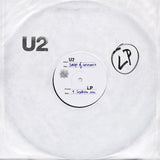Songwriting Tip: U2 "Raised By Wolves"
 The new U2 track, “Raised By Wolves,” of the “Songs of Innocence” is an excellent example of great songwriting in terms of building melodic intensity and climax. The melody of each section of the song — verse to lift to chorus — slowly moves up in pitch little by little. Any songwriter can learn from what Bono and the boys are doing here. Let’s take a closer look:
The new U2 track, “Raised By Wolves,” of the “Songs of Innocence” is an excellent example of great songwriting in terms of building melodic intensity and climax. The melody of each section of the song — verse to lift to chorus — slowly moves up in pitch little by little. Any songwriter can learn from what Bono and the boys are doing here. Let’s take a closer look:
Verse: The melody of the verse ranges from Eb to Bb (C2), seven half steps, with the melody generally moving in a downward direction.||
Lift or pre-chorus: The lower verse melody is then followed by “I don’t believe anymore,” which takes us a little higher and tends to move in an upward direction. The range of the melody in this section is from the Eb of the next octave (C3) all the way up to an Ab. The melodic range of the lift is five half-steps.
We should note here that the verse-lift cycle is repeated twice before the payoff of the chorus comes, thus extending the intensity of the build. And making the payoff in the chorus that much more pleasurable. The full chorus does not start until 1:40 into the song, which is a lot longer than your average pop song. However, the lift does take the melody high enough to keep the listener’s attention.
Chorus: The song climaxes at its highest point with “Raised by Wolves,” with “Raised” landing the listener at a Bb. It’s just one full step higher than the highest note in the lift — Bb in C3, but it seems like a lot more than this because the last note of the lift is an Eb. So the distance between the last word of the lift (“anymore”) and first word of the chorus (“raised”) is seven half-steps. Overall, the chorus occupies the same space as the verse, but a full octave higher (Eb up to Bb in C3). This is pleasing to the listener because it is “familiar” territory but “new” because it is an octave higher. Put this into songwriting practice by analyzing a few of your own songs. While not every pop song works this way, many of them do. “Raised By Wolves” is a great model for those that do. Many great pop songs utilize this strategy of slow building melodic intensity in each song part.
Put this into songwriting practice by analyzing a few of your own songs. While not every pop song works this way, many of them do. “Raised By Wolves” is a great model for those that do. Many great pop songs utilize this strategy of slow building melodic intensity in each song part.
— Quint Randle
Quint is a Pearl Award-winning songwriter, co-founder of Drums On Demand, co-founder of Gig Magazine and author of the book Making Money Making Music.
